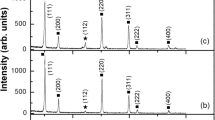Abstract
Though some important progress in the excellent mechanical properties of zirconium alloys have been reported, their high surface hardness and good wear properties need to be explored further. In this work, a carburized layer was formed on the surface of commercially pure zirconium by a double glow plasma hydrogen-free carburizing technique. Commercial high-purity graphite was used as the carbon source material. X-ray diffraction (XRD), scanning electron microscopy (SEM), energy dispersive spectroscopy (EDS), Vickers hardness test, friction and wear test were used to characterize the samples carburized. The carburized layer could be clearly observed under a microscope. XRD patterns indicate that the zirconium carbide phase is formed in the carburized layer. The surface hardness of the sample increases significantly after carburization. Friction and wear tests results show that wear resistance and friction coefficient of zirconium are improved considerably after carburization. Surface plastic deformation is arrested to a low extent in contrast with pure zirconium because of the presence of ZrC phases during the wear test. The results may provide new insight into methods for surface strengthening of zirconium alloys.
Graphical Abstract
A carburized layer was formed on the surface of commercially pure zirconium by a double glow plasma hydrogen-free carburizing technique. The carburized layer could be clearly observed under a microscope. X-ray diffraction (XRD) patterns indicate that the zirconium carbide phase is formed in the carburized layer. The surface hardness of the sample increases significantly after carburization. Friction and wear tests results show that wear resistance and friction coefficient of zirconium are improved considerably after carburization

.





Similar content being viewed by others
References
Qin W, Szpunar JA, Kozinski J. Hydride-induced degradation of hoop ductility in textured zirconium-alloy tubes: a theoretical analysis. Acta Mater. 2012;60(12):4845.
Liang SX, Ma MZ, Jing R, Zhang XY, Liu RP. Microstructure and mechanical properties of hot-rolled ZrTiAlV alloys. Mat Sci Eng A. 2012;532:1.
Feng ZH, Jiang XJ, Zhou YK, Xia CQ, Liang SX, Jing R, Zhang XY, Ma MZ, Liu RP. Influence of beryllium addition on the microstructural evolution and mechanical properties of Zr alloys. Mater Design. 2015;65:890.
Liang SX, Ma MZ, Jing R, Tan CL, Liu RP. Structural evolution and mechanical properties of Zr–45Ti–5Al–3V alloy by heat treatments. Mat Sci Eng A. 2012;541:67.
Xue WB, Zhu QZ, Jin Q, Hua M. Characterization of ceramic coatings fabricated on zirconium alloy by plasma electrolytic oxidation in silicate electrolyte. Mater Chem Phys. 2010;120(2–3):656.
Zang CC, Wang YZ, Zhang YD, Li JH, Zeng H, Zhang DQ. Microstructure and wear-resistant properties of NiCr–Cr3C2 coating with Ni45 transition layer produced by laser cladding. Rare Met. 2015;34(7):491.
Li Y, Zhang F, Zhao TT, Tang M, Liu Y. Enhanced wear resistance of NiTi alloy by surface modification with Nb ion implantation. Rare Met. 2014;33(3):244.
Bailey R, Sun Y. Pack carburisation of commercially pure titanium with limited oxygen diffusion for improved tribological properties. Surf Coat Tech. 2015;261:28.
Kim JH, Lee MH, Choi BK, Jeong YH. Effect of the hydrogen contents on the circumferential mechanical properties of zirconium alloy claddings. J Alloy Compd. 2007;431(1–2):155.
McRae GA, Coleman CE, Leitch BW. The first step for delayed hydride cracking in zirconium alloys. J Nucl Mater. 2010;396(1):130.
Xu Z, Liu X, Zhang P, Zhang Y, Zhang G, He Z. Double glow plasma surface alloying and plasma nitriding. Surf Coat Tech. 2007;201(9–11):4822.
Liu HB, Tao J, Xu J, Chen ZF, Gao Q. Corrosion and tribological behaviors of chromium oxide coatings prepared by the glow-discharge plasma technique. Surf Coat Tech. 2009;204(1–2):28.
Wu HY, Zhang PZ, Li JL, Hussain G, Xu Z. The friction and wear properties of Ti–Al–Nb intermetallics by plasma surface alloying. Tribol Lett. 2008;30(1):61.
Gu DP, Yang YL, Qi XW, Deng W, Shi L. Influence of weave structures on the tribological properties of hybrid Kevlar/PTFE fabric composites. Chin J Mech Eng-En. 2010;25(5):1044.
Asl KM, Masoudi A, Khomamizadeh F. The effect of different rare earth elements content on microstructure, mechanical and wear behavior of Mg–Al–Zn alloy. Mat Sci Eng A. 2010;527(7–8):2027.
Ji YP, Wu SJ, Xu LJ, Li Y, Wei SZ. Effect of carbon contents on dry sliding wear behavior of high vanadium high speed steel. Wear. 2012;294–295:239.
Chen K, Li ZQ, Liu JS, Yang JN, Sun YD, Bian SG. The effect of Ba addition on microstructure of in situ synthesized Mg2Si/Mg–Zn–Si composites. J Alloy Compd. 2009;487(1–2):293.
Yang LJ. Wear coefficient equation for aluminium-based matrix composites against steel disc. Wear. 2003;255(1–6):579.
AjithKumar KK, Pillai UTS, Pai BC, Chakraborty M. Dry sliding wear behaviour of Mg–Si alloys. Wear. 2013;303(1–2):56.
Qin QD, Zhao YG, Zhou W. Dry sliding wear behavior of Mg2Si/Al composites against automobile friction material. Wear. 2008;264(7–8):654.
Qi QJ, Nonferr T. Evaluation of sliding wear behavior of graphite particle-containing magnesium alloy composites. T Nonferr Metal Soc. 2006;16(5):1135.
Ghosh SK, Saha P. Crack and wear behavior of SiC particulate reinforced aluminium based metal matrix composite fabricated by direct metal laser sintering process. Mater Design. 2011;32(1):139.
Buckley DH. Surface Effects in Adhesion, Friction, Wear and Lubrication. New York: Elsevier Scientific Publishing Company; 1981. 89.
Wang J, Xing JD, Cao L, Su W, Gao YM. Dry sliding wear behavior of Fe3Al alloys prepared by mechanical alloying and plasma activated sintering. Wear. 2010;268(3–4):473.
Acknowledgments
This work was financially supported by the National Basic Research Program of China (No.2013CB733000) and the National Natural Science Foundation of China (Nos. 51271161, 51271162 and 51434008).
Author information
Authors and Affiliations
Corresponding author
Rights and permissions
About this article
Cite this article
Wang, JQ., Yang, HB., Zhang, B. et al. Double glow plasma carburization on zirconium to improve surface hardness and wear resistance. Rare Met. 36, 569–573 (2017). https://doi.org/10.1007/s12598-016-0748-x
Received:
Revised:
Accepted:
Published:
Issue Date:
DOI: https://doi.org/10.1007/s12598-016-0748-x




